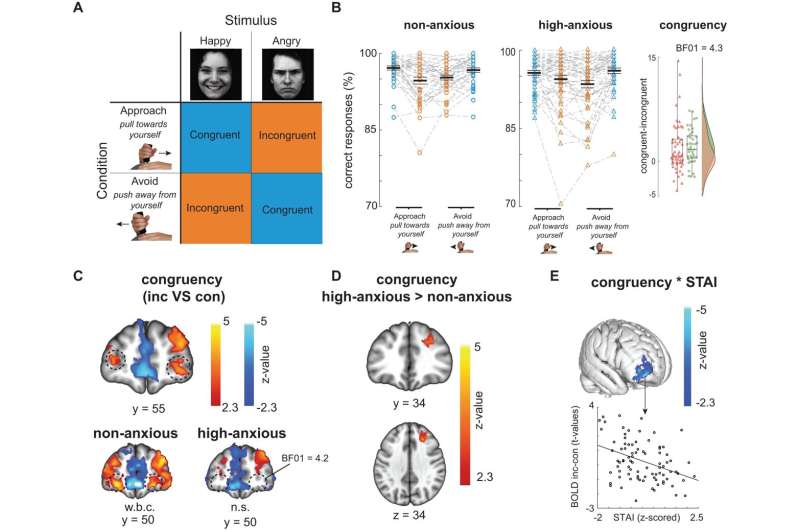This article has been reviewed according to Science X's editorial process and policies. Editors have highlighted the following attributes while ensuring the content's credibility:
fact-checked
peer-reviewed publication
trusted source
proofread
Anxious people use less suitable section of brain to control emotions

When choosing their behavior in socially difficult situations, anxious people use a less suitable section of the forebrain than people who are not anxious. This can be seen in brain scans, as shown by the research of Bob Bramson and Sjoerd Meijer at the Donders Institute of Radboud University.
For example, an anxious and a non-anxious person both run into someone whom they've been in love with for quite some time. Both of them find this tense and both would like to ask the person out on a date. But do you walk up to that person? Or do you pretend not to see them to avoid embarrassment?
Whereas the non-anxious person can put aside this emotion and choose behavior that allows them to approach the potential lover, this is much more difficult for an anxious person. Bramson states, "Anxious people use a less suitable section of the forebrain for this control. It's more difficult for them to choose alternative behavior, so they avoid social situations more often."
Decisions like this demand a balancing act between a possible threat and a reward, a decision that non-anxious people make in the prefrontal cortex. The researchers at Radboud University have now shown that socially anxious people use a different section in the forebrain for decisions like this.
Brain scans
Bramson and Meijer studied brain scans to see what happens in anxious and non-anxious people in a simulated social situation. "Our trial subjects were shown happy and angry faces and had to first move a joystick towards the happy face and away from the angry face. At a certain point they had to do the reverse: move towards an angry face and away from a happy face. This demands control over our automatic tendency to avoid negative situations."
Anxious people proved to perform just as well as non-anxious people in this simple task, but the scans showed that a completely different section of the brain was active. "In non-anxious people we often see that, during emotional control, a signal is sent from the foremost section of the prefrontal cortex to the motor cortex, the section of the brain that directs your body to act. In anxious people a less efficient section of that foremost section is used."
Other scans showed that the reason for this is probably because the "correct" section becomes overstimulated in anxious people. "This could explain why anxious people find it difficult to choose alternative behavior and thus avoid social situations. The disadvantage of this is that they never learn that social situations aren't as negative as they think."
For the first time, brain scans have now shown that the forebrain of anxious people works differently from that of non-anxious people with regard to control of emotional behavior. The researchers think that the results could be used to develop new treatments for people with anxiety.
More information: Bob Bramson et al, Anxious individuals shift emotion control from lateral frontal pole to dorsolateral prefrontal cortex, Nature Communications (2023). DOI: 10.1038/s41467-023-40666-3




















